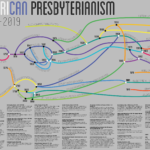Summarizing Distinctives of Reformed Faith and Practice
A friend asked me the other day what I thought were the key 4-5 distinctives of Reformed theology. I gave my answer, but have found myself pondering that question. Reformed theology is not just about reforming doctrine, but practice. It’s an embodied, lived tradition of the church. So what separates Reformed faith and practice from other Christian traditions, particularly the (Ana)Baptist, Lutheran (though there is a lot of overlap here), Pentecostal, Roman Catholic, and Wesleyan traditions? I think the best resources for a quick overview are John Calvin’s The Necessity of Reforming the Church (1544), William Perkin’s A Reformed Catholic (1597), and R. Scott Clark’s Recovering the Reformed Confessions (2008). So Reformed churches are,
Catholic and Creedal. The Reformed are Reformed Catholics (in distinction to Roman or Eastern Orthodox Catholics) and fully embrace the Catholic tradition expressed in the Apostles’, Nicene, Chalcedonian, and Athanasian creeds. To be Catholic is to affirm and submit to Nicene Christianity as biblical Christianity. Nicene Christianity in particular defines the biblical and Catholic doctrines of the Trinity and Christ’s divinity and humanity. The Reformed also affirm and look to the church fathers for guidance.
Sola Scriptura. All Christians affirm the authority of scripture, and the Reformed are no different. Where differences lie is in the uniqueness…
Christ’s Descent Into Hell
A pastor friend of mine and I were discussing the meaning of this phrase in the Apostles’ Creed, stimulated by Ligon Duncan’s recent article on the subject. Duncan helpfully lists out a number of options for its meaning:
- That it refers to the spiritual agony Christ felt on the cross. This is the meaning put forth by the Heidelberg Catechism (Q&A 44) and held by John Calvin (Institutes 2.16.8-10). Duncan rejects this as the historic intent of the phrase since it comes the after burial of Christ in the creed.
- That it refers to Christ descending into hell and freeing Old Testament saints from captivity and bringing them with him to heaven. The idea here is that Sheol/Hades/Abraham’s Bosom all refer in various ways to the abode of the dead in general, with the dead being sorted into hell and heaven only after the redemptive-historical work of Christ. Calvin strongly rejected this view, but modern Reformed thinkers like J. I. Packer and Sinclair Ferguson teach a modified version of it.
- That Christ was providing a second chance to the damned to repent, which Duncan, correctly, rejects.
- Duncan emphatically ruled out the possibility that Jesus was paying for sins by suffering in hell, a view common to the Word of Faith movement.
- That it refers to the fact that Jesus really, truly died and continued in the state of death. Duncan accurately states that this is both the intent of the creed, and also that it is the view that best fits with scripture. This is the view taught in the Westminster Larger Catechism (Q&A 50).
Interestingly, Duncan doesn’t mention the historic Lutheran view that Christ descended into hell in victory, smashing the power of the devil (e.g. Formula of Concord, IX), though this view does overlap a bit with the idea that Christ in his death freed the Old Testament saints…

